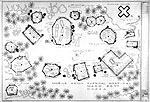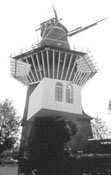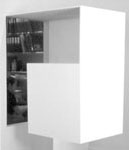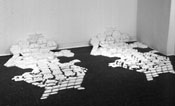| |
The following curatorial essay by Betti-Sue
Hertz was written for the exhibition catalogue for Transposed:
Analogs of Built Space which took place at the Sculpture Center,
New York, March 30-May 6, 2000
 |
|
|
The process of designing buildings has changed
dramatically over the last fifteen years as the use of computer
assisted design software has replaced the hand drawn plan. This
shift has yielded a whole new generation of architecture. Frank
Gehry's much celebrated Guggenheim Museum Bilbao completed in 1997
is a convenient example for illustrating the particular effect of
digital imagining on new building design. Gehry's several quick
drawn sketches on hotel stationary made in 1991 directly after his
visit to the museum's present site mark the genesis of the building's
monstrous beauty. The sketches are rough but already suggest the
shape, feeling, and imagery of the end product. His first competition
model already exhibited the museum's cubistic exterior surfaces
replacing the sinuous line of the linear sketches with bulk and
mass to form the undulating shapes of ship, water landscape, and
tower. The initial conceptualization of the museum's sculptural
skin was achieved through model making and a computer program called
Catia which was originally developed for the French aerospace industry
aided in the refinement and engineering.
The Guggenheim Museum Bilbao is a strange
belated example of Analytic Cubism, a post-modern enlargement and
no less than a transposed remake of the tenets of Cubism. Moreover,
it finally fulfills the ambitions set out by the architectural modernists
of the 1920s, when the historian Sigfried Giedion suggested that
the architects were quot;looking to cubist painting to find a model
for spatial experience that would be appropriate to modern architecture."
The corollaries are particularly suggestive when looking at Braque's,
Harbor in Normandy and Fishing Boats, both from 1909,
works that in their time represented a breaking point for a new
visuality of real things in space. Conversely it is also possible
to trace the origins of Cubism to architectural form. In the summer
of 1909 Picasso took a sojourn to Horta de Ebro, Spain, where, influenced
by the cubic forms of the vernacular architecture, he painted his
first analytic cubist works including The Reservoir, Horta.
Why is Gehry, one of post-modernism's masters,
borrowing from such an old and worn out model of modernism? Is it
ironic that he fulfills the cubist model so successfully thanks
to capabilities of computer software? Why is there so much analog
sensibility in his digitally-generated form? Gehry has boldly veered
into the realm of sculpture before with his repeated renditions
of fish and snakes, most notably in works such as the Fishdance
restaurant in Kobe, Japan, 1987 and his fish lamp designs of Colorcore
Formica. Influenced by his artist friends such as Richard Serra
and Claes Oldenburg, he has unashamedly borrowed from the visual
canon of painting and sculpture.
 |
|
|
But why spend the first part of this essay
on the exhibition, "Transposed: Analogs of Built Space,"
which presents the work of visual arts who adapt the idiom of architectural
models and plans, by summarizing a master work by a famous architect?
Whereas Gehry may be fascinated with a now defunct ideology in the
visual arts (which he's reinvigorated under the auspices of architecture),
more and more contemporary artists are mining the detritus of earlier
paradigms and practices of architects. Why is this fascination with
the "sister" other, the oft paired art and architecture,
blossoming now? Trying to grasp the condition of architecture, reverentially
imitating, using and even abusing it is the very thing that is sparking
new work by young artists impersonating the practice of architecture.
Their work apes the visual language, symbolic functions, ideals,
and construction methods of architecture. Yet their work is not
architecture. The six artists in Transposed: Analogs of Built Space
ease their task of creating an approximate equivalent to architecture
by creating work in the idiom of models and plans, forms which are
already referents for larger built projects. These works are spin
offs, interpretations, almost dalliances in conversation with architecture's
past. The six artists-Mark Bennett, Steven Brower, Javier Cambre,
Toshihiro Komatsu, Elke Lehmann and Sarah Oppenheimer-are, like
their paper architect counterparts, freed from the demands of functionality.
Their handmade works resist the virtual world of cyber architecture
and their practice is also distinct from the research architect
who is primarily interested in experimental or theoretical explorations.
 |
Steven Brower, Falling Lumber (detail), 1997, Plastic,
wood, paint, metal, photos, paper, dimensions variable, Collection
of the artist, Photo: Stephan Freid.
|
In the past architects used the model and
plan as a tool in the design process. For the most part, architects
now use these forms for presentation purposes to promote their ideas
to clients and other interested parties. The model, which by definition
is a referent for something else, shifts the body's time-space relationship
through its miniaturized scale. In real space we cannot experience
a view from inside the building and a view from outside the building
simultaneously. We experience things from a variety of spatial positions
as we move through space. But the model presents the whole almost
all at once. It is more manageable than the fully sized thing, more
illusory, more tentative, and can live in the realm of the incomplete
more easily. Shrinking and miniaturization combine "with imitation,
with the second-handedness and distance of the model." The
works in Transposed, make literal reference to a specific original
that can be as fictive as Bennett's plans of television houses or
as real as Lehmann's one third scale model of the director's office
at the Sculpture Center. Each artist is therefore reworking an image
already encoded with a specific history. This relationship between
original and its respondent grounds these works in the past. Like
Gehry's Guggenheim Museum Bilbao these works rely on historical
precedents in order to be fully alive in the present.
Each artist in Transposed has taken a unique
approach to the issues raised above. Mark Bennett builds a fiction
out of a fiction by designing plans of television houses using information
gleaned from TV studio sets, neighborhood scenes, and dialogue.
After repeated viewing of serial shows such as The Brady Bunch and
Bewitched he maps out the building and surrounding landscape that
spatially frames the action of the characters. He redoubles on the
fictional space and concretizes it. However, as he has not been
especially trained in architectural drawing, his renditions render
another kind of falseness, an inaccurate account of that which doesn't
exist. Yet drawn with a close enough approximation to the clues
presented on TV, he has put together fragments that are barely perceivable
to the average viewer. He takes advantage of the nature of the plan-to
give an overview of the various rooms and floors which are impossible
to experience simultaneously.
Whereas Bennett concretizes fictions Javier
Cambre overlays his own interpretation onto an architectural source
with a role in a well known film. His representations of the Casa
Malaparte (1938-42), a modernist Italian villa that sits on top
of a cliff in Capri, are dependent on its function as the central
location for Jean-Luc Godard's film Contempt (1963) starring Brigitte
Bardot, Michel Piccoli and Jack Parlance. The stucco Pompeiian red
villa was designed by its owner, the writer Curzio Malaparte best
known for his book Kaputt (1946), a fictional account of his journalistic
experiences during World War II. The film also features a cameo
appearance by Fritz Lang, the director of the German Expressionist
film Metropolis (1926). Contempt is ostensibly about a French couple,
a screenwriter and his wife, and their relationship to an American
film producer. The artist has stated: "I believe Godard chose
the house as a site for his movie because he was making an analogy
between the failure-tragedy of modernism and the failure-tragedy
of a contemporary couple and at the same time the tragedy of filmmaking.
Contempt is a movie about making a movie about the Greek tragedy
of Ulysses." Cambre's project is conceptually situated on top
of these layers of this referential evidence. Using furniture, prints,
and a brochure, his installation uses the plan of the villa to represent
masculine desire for power and the female character's lack of independent
identity and contempt for her husband's ineffectualness. The tension
of this heterosexual dynamic is represented in a repeated motif,
which depicts the phallic shape of the building with a sharp point.
The form penetrates and is surrounded by the wavy lines of the contours
of land and elevation. The villa is simultaneously revealed to be
both a boat floating at sea and a signifier of sex. The building
is more and less than itself. It becomes an object whose physicality
is secondary to the uses the film makes of it and its availability
as a symbol of desire.
While Bennett's and Cambre's plans and models
respond to fictional narratives, Steven Brower's projects mine the
historiography of a building's reception and biography to create
skewed adaptations of specific canonical works. His humorous detailed
models disarm the sanctity of high architecture. A big fan of Buckminster
Fuller Brower created Messiah Complex (1997) as a homage both to
Fuller's inventive geodesic domes of the 1940s and his iconoclasm.
Reflecting on the cultural history of the dome, Brower incorporates
two adaptive uses into one model. The top half depicts a comfortable
rural home replete with wood stove and weaving loom and the bottom
half depicts an underground survivalist barrack. The two halves
were inspired by the two factions that embraced the design-hippies
seeking affordable, do-it-yourself shelters that blended with their
back-to-nature aesthetics and the United States military looking
for solutions for quick-to-build bunkers to house victims of war
and disaster. Brower grew up in part in rural West Virginia in a
simple shed style house that was pretty dilapidated when the family
arrived from the suburbs of Washington, D.C. The family pastime
was to improve the house by fixing up the existing structure and
making additions. The result was a confusing mess, but it blended
well with its rural surroundings. These childhood experiences are
the basis of Brower's house and fictional housing development Falling
Lumber (1997), a spoof on the most revered American house, Frank
Lloyd Wright's Falling Water (1936) as well as Wright's foray into
mass produced low income housing design, the Usonian houses (1936-1953).
Plans, photographs, and a brochure accompany two models, one of
the house and another of a planned community, as if prospective
buyers would want to buy a copy of Brower's fictive speculation
house based on his family home.
 |
Toshihiro Kamatsu, Artist and His Studio, Amsterdam,
1996, Photographic documenation of wearable model of ATELIER
217, Photo dimension: 29x19", Model: Plywood, polystyrene,
plexiglass mirror, Model dimension: 15x21x27", Collection
of the artist, Photo: Tanja and Roderick Henderson.
|
Toshihiro Komatsu's work is about the locations
he has encountered, built space and nature. Since leaving his hometown
of Hamamatsu City to attend university in 1991 Komatsu has been
on a nomadic journey, first as a student in Tokyo, then as a post
graduate fellow at the Rijksakademie van beeldende kunsten in Amsterdam,
next as a graduate student at M.I.T. in Cambridge, Massachusetts
and presently living in New York. Pieces of this journey have been
documented in his extensive explorations of the buildings in which
he has lived and worked, or those nearby. He defines his relationship
to each new place by investigating its particularities often creating
multiple works in response to a singular architectural case. While
in Amsterdam (1994-96) Komatsu created a variety of works where
he realigned the traditional spatial relationships between inside
and outside and transposed the scale and location of his studio.
In each medium-model, photography, collage, drawing-Komatsu represented
another perspective on the singular space of the studio. His investigations
took the form of installations in the studio and scaled-down replicas
of it in varying sizes placed in different situations. In his 1996
series, Artist and His Studio (a title which coyly makes reference
to Rembrandt's paintings of the same name), a performer walks around
the city with the model of the studio over his head posing in front
of various emblematic sites such as a windmill. The studio is metaphorically
lifted from its original situation on the third floor of an institutional
building, and takes on the wandering identity of the artist's nomadic
condition. In several other works, the window, that liminal element,
is the open channel for bringing light, air and sky inside thereby
dissipating the feeling of containment. For Atelier 217 (1995) Komatsu
opened up the paper scale model of the studio into a flat shape
and created a cut out that can be folded back into a box. Images
of day sky and night sky, representing nature and infinite space
contradict the limiting qualities of the box. Komatsu's various
works reveal both an attraction and aversion to the limits of built
space in light of continual transience.
 |
|
|
Elke Lehmann's site specific installation
Office (2000) sets up a phenomenological situation between the existing
spaces of the Sculpture Center and a constructed box. Initially
the viewer sees a raised box with an "L"-shaped side opening
protruding into the space of the gallery and then a window with
a view to the director's office on the other side of the gallery
wall. The box is a suspended one third scale model of the office.
Once inside, the interior of the replica fits snuggly around the
body with the imaginary floor starting around the viewer's knees.
The intimacy of the enclosure effects one's kinesthetic sense of
space and the relative qualities of bigness and smallness. An encounter
between gallery visitor and gallery staff may (or may not) occur.
However, the gallery visitor can look into the office with its desk,
shelves, books, computer, phone, etc. in full view. The view from
the director's side is totally different. The window allows for
a partial view of the gallery, an intimate view of the interior
of the box and possibly the person who may stand inside it. The
window is used to full metaphoric function revealing the contents
of the space on the other side of the wall. It sets up a situation
for expectation and voyeurism, while making the participant self-conscious
about being looked at, with the added anxiety of the possibility
of a close encounter interrupting the director's daily routine.
Lehmann's installation is both a scale model, and an intervention
of the institutional art space-a strategy developed by Conceptual
artists of the late-1960s and early 1970s such as Michael Asher
and Daniel Buren. Sarah Oppenheimer's Terrain Projects (1999) are
abstract diagrammatic representations of the public spaces of cities.
Her representations are based on sections of the urban grid in midtown
Manhattan. Not focused on an individual building or room she explores
urban terrain as a spatial concept based on the density of human
movement in the built environment. The structure of geographic space
is represented in three dimensions through the patterning and grouping
of relief building structures on interlocking hexagonal and diamond
shaped tiles. A graphic mapping of the human patterns of movement
is set onto a dense color-coded diagram that becomes abstract through
the layering of specific strategic information. Oppenheimer has
taken the inspiration for her approach to mapping the pattern of
the ebb and flow of pedestrians from a rather sinister source, military
manuals on tactics and strategies for successful attacks on cities.
According to Oppenheimer's scheme the correlation between the task
of the planner and military strategist is not very far apart as
mass human behavior and it's regulation is very much part of the
urban planner's job. She achieves a complexly coded abstract image
through a scientific approach to urban planning.
 |
|
|
By engaging the idiom of architectural models
and plans, the visual artists in Transposed reconceive already existing
places with an acute sensitivity to the cultural specificity of
place-domestic architecture, studio and exhibition space, or urban
grid. Through displacement, slippage, and mapping they respond to
modern architecture, the framing function of buildings, and the
imagined spaces of media culture, reassigning the symbolic attributes
of the "original." Ultimately, they adapt the structural
configurations and conceptual modes of architecture and design to
their own will.
Author's Bio>>
|
|